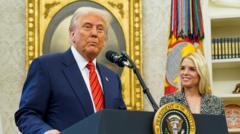Despite recent talks between China and the U.S. resulting in reduced tariffs, concerns linger over persistent trade imbalances and geopolitical tensions.
China's Trade War Standoff with the U.S. Shows Signs of Softening

China's Trade War Standoff with the U.S. Shows Signs of Softening
Negotiations yield tariff reductions but underlying tensions remain unresolved
In a striking shift in tone, Beijing has engaged in high-stakes negotiations with Washington, producing a compromise on tariffs aimed to alleviate pressure on both economies. The trade war, defined by taboo confrontations and strong rhetoric, has seen tariffs wreak havoc on both nations’ markets. Nevertheless, the recent discussions, including a robust two-day exchange in Geneva, have led to a temporary reprieve.
Critics might remember the days when China portrayed its resolve with assertive statements, such as "We will not back down," broadcasted from the Ministry of Foreign Affairs. However, recent talks indicate an apparent shift towards cooperation. U.S. Treasury Secretary Scott Bessent remarked that both parties seemed to have come to an understanding that neither desires a complete decoupling in trade relations.
Economists have heralded the new agreement as an unexpected positive development, with tariffs on Chinese imports reduced from previously steep rates to 30%, and tariffs on American goods dropping to 10%. Zhiwei Zhang, chief economist at Pinpoint Asset Management, noted the significance of this change, signaling a decreased level of investor anxiety regarding potential disruptions in global supply chains.
Trump's social media enthused over what he dubbed a "total reset negotiated in a friendly, but constructive, manner," but analysts caution against future tensions. China's softened public relations strategy belies underlying worries about their economic stability, impacted by property market troubles and rising unemployment. The nation, still a critical trade partner for many countries, is feeling the strain as consumer confidence wanes, coupled with a recent decline in its consumer price index.
The Chinese Commerce Ministry welcomed the tariff agreement, describing it as critical for resolving differences and enhancing cooperation. This optimistic tone contrasts with China’s past hardline stance, yet Beijing remains wary. In an echo of previous sentiments, the ministry emphasized the need for the U.S. to correct its unilateral tariff approach.
Reporting from Xinhua warns that China's goodwill has limitations, advising Washington against missteps that could spark renewed conflict. Analysts believe President Xi Jinping is testing his domestic and international mettle, aiming to protect China's image as a steadfast global player.
Despite the temporary cessation of escalating tariffs, both nations grapple with the structural issues that have led to trade imbalances, geopolitical anxieties, and the specter of future discord. As negotiations unfold, the complex dynamics of U.S.-China trade relations remain on a knife edge, with ongoing discussions poised to dictate the future landscape. The battle has not concluded; it has rather transitioned from physical trade routes to strategic negotiations, retaining a fervent undercurrent of competition.





















